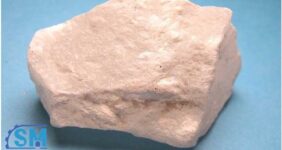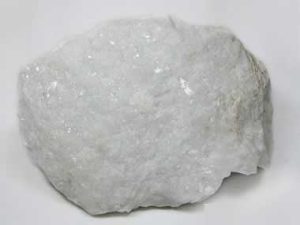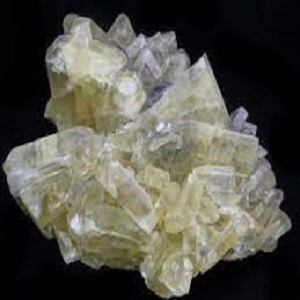Characteristics of barite stone
Barite is a natural compound of barium sulfate with the formula BaSO4, which is also known as Heavy Spar, which is among the group of sulfates. The name barite is derived from the Greek word barys meaning heavy and because of its special and high weight. Its crystallization system is orthorhometric. The most important barium containing minerals are: (BaSO4) and Vitrite (BaCO3). Barite is more abundant than Vitrite. Barite is found in nature in the form of veins, layers and remnants
Barite is one of the common minerals of veins and usually appears together with quartz and calcite. It is also found in limestone and sandstone, and in some concretions, its amount is high, but in any case, it is rare as the primary mineral of rocks. Its important feature is that it is very heavy compared to other non-metallic materials. This mineral is an industrial mineral and it is widely used in industry
Barite often exists as solidifications and void-filling crystals in sediments and sedimentary rocks, and is especially common as a vein filler in limestone and dolostone. In places where these carbonate rocks are heavily weathered, sometimes there is a large accumulation of this compound in the contact between the soil and the substrate. Many commercial barite mines are produced from these residual deposits
This material is also found in sand and sandstone. Sometimes its crystals in the sand turn into interesting shapes. These formations are known as “barite flowers” and they can be several inches long and contain many grains of sand

Physical properties of barite
This mineral is usually easy to recognize because it is one of the few non-metallic minerals with a specific gravity of four or more
Barite specifications
Barite is normally white to light gray, but it may also be seen in blue, brown or black colors. Barite is a dark Opeque mineral and has a shell to glassy luster. Type 1 samples are seen as elongated orthorhombic crystals, but the commercial type is prepared in the form of grains, crystalline masses, or fragments
The specific gravity of this mineral is high and is around 4.3 to 4.6. This characteristic helps a lot to identify it. The hardness of barite has a considerable range of changes and varies from 2.5 to 3.5, which usually produces different areas with different hardness

How barite is formed
Barite is a common mineral with wide distribution. Usually as a waste mineral in thermal veins along with ores of silver, lead, copper, cobalt, manganese, antimony and also in veins in limestone with calcite or as open masses in clays covering limestones and also in sandstones. It is found with copper ores and acts as a cement for sandstones in some areas. Sometimes it also precipitates from spa springs
The important places of occurrence of barite crystals are Destmorland and Cumbria, England, Fessobania and other regions of Romania and Saxony, Germany. They are mainly mined as veins, nests and irregular masses in limestones or united dolomite in Georgia, Texas, Missouri and Arkansas

Forms of barite formation
Vein type
Thermal and magma solutions that have specific chemical compounds lead to the formation of barite in faults, fractures and the empty space between particles and pieces of rock. Along with some thermal deposits of silver, lead, zinc and fluorite, barite is also seen
Volcanic sedimentary type
Layered barite deposits are more related to masiosulfide deposits and stratiband deposits of sedimentary stratiform. In crocobarite-type masiosulfides, it is found in the upper part and around the masiosulfide deposit. Barite-bearing layers have been reported in some stratiband deposits of the sedimentary stratiform. Barite is seen in layers and sometimes as rock cement. The barite-bearing layers are mostly gray in color, ending in chert and siliceous shales from above and around. Its amount varies between 50 and 95 percent
?What is barite and what is its application in industries
Applications of barite
This compound is most widely used as a weighing agent in drilling muds. This is what 99% of barite in the US is used for
This mineral is also used as a pigment in paints and as a weight filler for paper, cloth and rubber. The paper used to make some playing cards contains this compound between its paper fibers. This material gives a very high density to the paper, which allows you to easily transfer cards to players around a table. This material is used as weight filler in tires and to make windproof tents for trucks
This compound is the primary barium ore used to make a wide variety of barium compounds. Some of these are used to protect against X-rays. Barite has the ability to prevent the emission of X-rays and gamma rays, and it is used to make high-density concrete to prevent the emission of X-rays in hospitals, power plants, and laboratories

Barite production method
The oil and gas industry is the main consumer of this compound worldwide. There it is used as a weighting agent in mud digging. It is a growing industry, as global demand for oil and natural gas has increased over the long term
This has increased the price of buying and selling barite. The price level in 2012 was between 10 and 20 percent higher than in 2011 in many important markets. The usual price of drilling barite mud is about 150 dollars per ton in the mine
Alternatives of this composition in drilling mud include celestite, ilmenite, iron ore and artificial hematite. None of these materials have been effective substitutes because they are very expensive or do not have competitive performance
China and India are the leading producers of this mineral and also have the largest reserves




